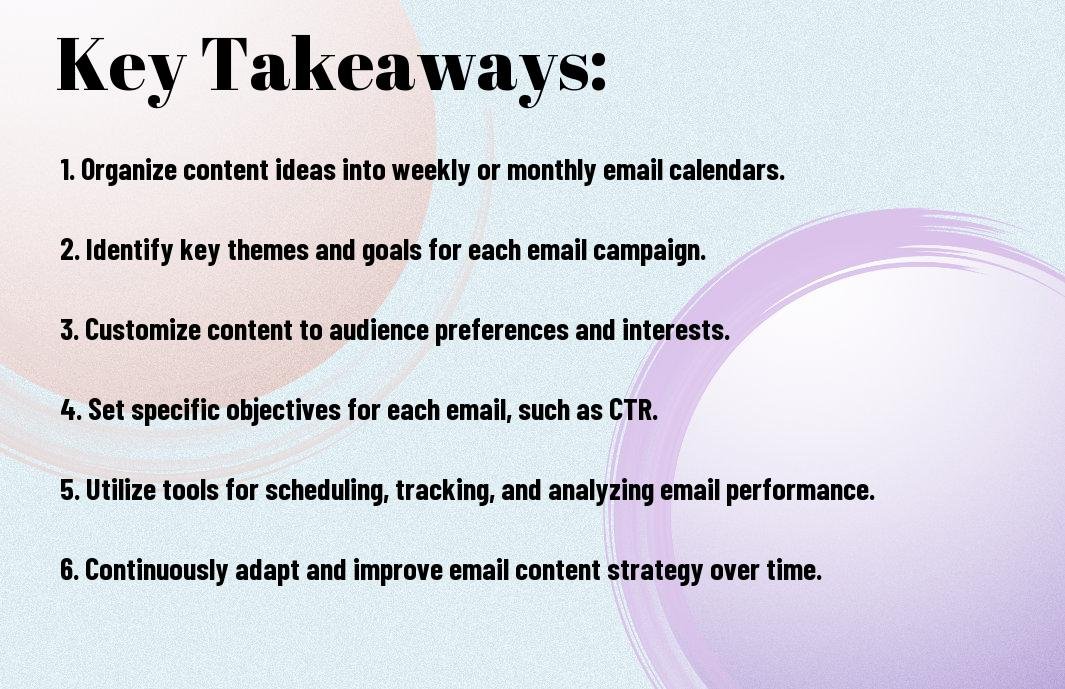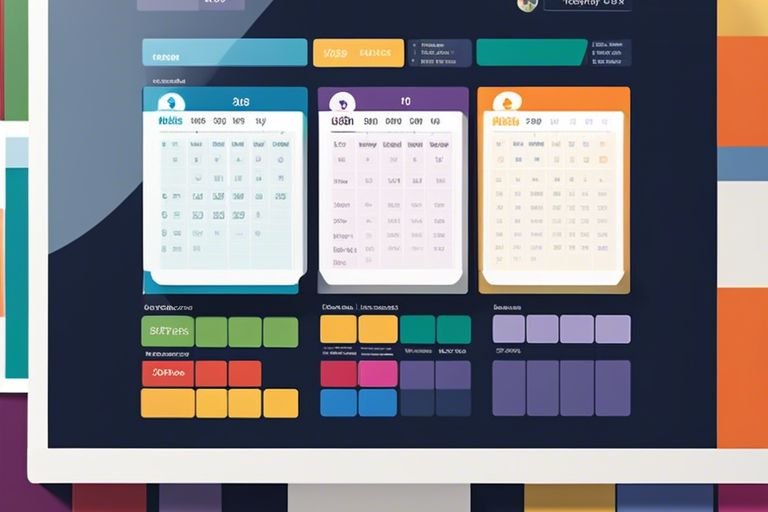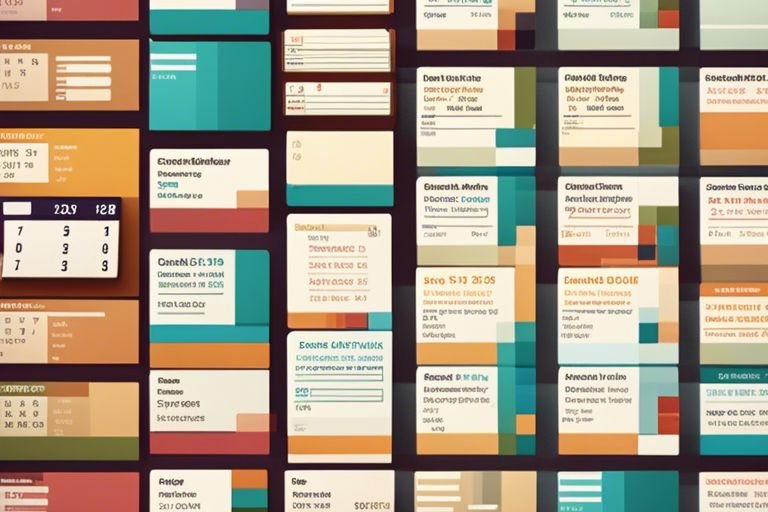Planning and organizing email content can be a daunting task, but with the right template in place, it can become a streamlined and efficient process. Ensuring consistent and engaging communication with your audience is crucial for any business or organization. This ultimate template will provide you with a comprehensive guide to effective email content planning and scheduling, helping you stay on top of your email marketing strategy and maximizing your results. From mapping out your content calendar to setting deadlines and analyzing performance, this template covers all aspects of email content planning to help you achieve your marketing goals seamlessly.
Key Takeaways:
- Consistency is key: Establish a regular schedule for sending out emails to keep your audience engaged and informed.
- Segment your audience: Tailor your email content based on the specific interests and needs of different segments within your email list.
- Strategic planning: Plan and create a content calendar to ensure your email communications align with your overall marketing goals.
- Personalization matters: Use the recipient’s name and personal details to create a more customized and engaging email experience.
- Monitor and optimize: Track the performance of your email campaigns and make adjustments based on the data to improve results over time.


Understanding Your Audience
Segmenting Your Email List
Some of the most effective email marketing campaigns are those that are tailored to specific segments of your audience. Segmenting your email list allows you to send targeted content that is more relevant to the recipients, increasing the chances of engagement and conversion. To do this, you can categorize your subscribers based on their demographics, behaviors, purchase history, or interests. By understanding the different segments of your audience, you can create personalized content that resonates with each group.
Personalizing Content for Your Readers
To create a more impactful email marketing campaign, it’s important to personalize content for your readers. Understanding your audience’s preferences, interests, and pain points can help you tailor your emails to their specific needs. Personalized emails have a higher open and click-through rate compared to generic ones, as they show that you value your subscribers as individuals. By using merge tags, dynamic content, and personalization tokens, you can create customized content that speaks directly to each recipient.
Understanding your audience on a deeper level can also involve analyzing their interactions with your previous emails, tracking their website browsing behavior, or conducting surveys to gather more insights. This information can help you create targeted content that addresses their specific needs and challenges, leading to higher engagement and conversion rates.
Content Planning for Email Marketing
Setting Your Email Marketing Goals
Email marketing goals set the foundation for your campaigns. Start by defining clear objectives like increasing open rates, click-through rates, or conversions. Make sure your goals are specific, measurable, achievable, relevant, and time-bound (SMART).
Developing a Content Strategy
With a solid content strategy, you can deliver value to your subscribers and keep them engaged. Understand your target audience, segment your list, and tailor your content to their needs and preferences. Consistent messaging and branding across all emails are crucial for building trust and loyalty with your audience.
Creating an Editorial Calendar
Marketing calendars help you plan and organize your email content effectively. Define key dates, events, or promotions in advance. Distribute content creation tasks among team members and assign deadlines. Include a mix of promotional and informational content to keep subscribers interested and engaged.
Email marketing goals drive your campaigns and help you measure success. With a content strategy, you can create targeted and valuable content for your audience. Plus, an editorial calendar ensures consistent delivery of content and keeps your campaigns on track. Marketing calendars are vital tools for successful email marketing campaigns. Calendar planning ensures that you provide timely and relevant content to your subscribers, leading to increased engagement and conversions.

Email Scheduling and Best Practices
Determining the Right Frequency and Timing
All successful email marketing campaigns require careful consideration of the frequency and timing of your emails. The key is to find the right balance between staying top-of-mind with your audience and avoiding overwhelming them with too many messages. The best approach is to test different schedules and analyze the performance metrics to determine the optimal frequency and timing for your specific audience.
Automating Email Campaigns
Campaigns
Automating email campaigns is a game-changer for businesses seeking efficiency and effectiveness in their marketing efforts. By setting up automated workflows based on user behavior or predefined triggers, you can deliver targeted and timely messages to your subscribers without constant manual intervention. Another benefit of automation is the ability to reach your audience at the most opportune moments, increasing engagement and conversions.

Measuring Success and Making Adjustments
Despite the meticulous planning and scheduling of your email content, it’s vital to measure its success to ensure you’re meeting your goals. Monitoring key performance indicators (KPIs) can help you understand how your audience is engaging with your emails and where adjustments may be needed. If you need help with organizing your email marketing efforts, check out 15+ Free Marketing Calendar Templates to stay on track.
Tracking Open Rates and Engagement
An vital aspect of measuring the success of your email campaigns is tracking open rates and engagement. By analyzing these metrics, you can assess the effectiveness of your subject lines, content, and call-to-action strategies. Understanding how your audience interacts with your emails can help you tailor future campaigns for better results.
A/B Testing and Analytics
Open up the possibilities for improving your email content by utilizing A/B testing and analytics. This powerful strategy allows you to test different email versions with small segments of your audience to determine which performs better. By analyzing the results, you can optimize your emails for higher engagement and conversion rates. Experiment with various elements such as subject lines, visuals, CTAs, and send times to find the winning formula for your audience.
Measuring and analyzing these metrics are crucial for making informed decisions about your email content strategy. By tracking open rates and engagement, you can identify areas for improvement and adjust your content to better resonate with your audience. Similarly, A/B testing and analytics provide valuable insights into what works best for your subscribers, enabling you to refine your email campaigns for optimal performance.
To wrap up
From above, we have examined into the details of creating the ultimate template for email content planning and scheduling. By following the structure and guidelines provided, you can streamline your email marketing efforts and ensure a consistent and engaging communication with your audience. Note, effective planning and scheduling are key to maximizing the impact of your email campaigns. By organizing your content, setting goals, and aligning with your overall marketing strategy, you can create compelling emails that drive results. Use this template as a foundational tool to optimize your email marketing strategy and watch your engagement and conversions soar.
FAQ
Q: What is the importance of having a template for email content planning and scheduling?
A: Having a template for email content planning and scheduling is crucial for maintaining consistency, organization, and efficiency in your email marketing campaigns.
Q: How can the ultimate template for email content planning and scheduling benefit businesses?
A: The ultimate template can help businesses streamline their email marketing efforts, improve communication with their audience, and ultimately drive better results.
Q: What key elements should be included in a template for email content planning and scheduling?
A: Key elements to include in a template are content calendar, email goals, target audience segmentation, subject lines, email copy, visuals, links, and scheduling dates.
Q: How often should email content planning and scheduling be reviewed and updated?
A: It is recommended to review and update your email content planning and scheduling template on a regular basis, ideally monthly or quarterly, to ensure relevance and effectiveness.
Q: What are some tips for effectively using the ultimate template for email content planning and scheduling?
A: Tips include setting specific goals for each email campaign, personalizing content for different audience segments, testing different strategies, analyzing performance metrics, and adjusting the template as needed for continuous improvement.

